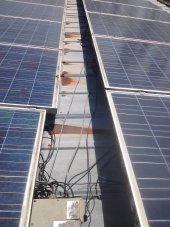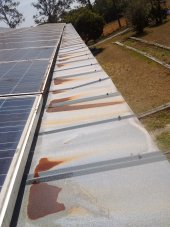I've got 40 panels feeding an old Fronius IG5100. There are 10 panels (230w) in each string (4 strings). Mid day I will at times see the production drop from like 4800 watts to 3600 watts. I have separate breakers for each string. At times, I can kill one string and see no change at the inverter level. So I know which string is flaky.
Now how to find the culprit panel or the connection. It's intermittent. When its working, if there is a panel issue, maybe I can one by one block the sunlight from part of it to inflict a pv drop. At times that string will contribute less to the pv current than the other strings. I have a clamp on dc meter. I don't think that helps me at all. I have checked all connections at the panels, nothing found. I'd rather not try to measure each panel on a meter by itself.
Just looking for thought I haven't had yet !!
Now how to find the culprit panel or the connection. It's intermittent. When its working, if there is a panel issue, maybe I can one by one block the sunlight from part of it to inflict a pv drop. At times that string will contribute less to the pv current than the other strings. I have a clamp on dc meter. I don't think that helps me at all. I have checked all connections at the panels, nothing found. I'd rather not try to measure each panel on a meter by itself.
Just looking for thought I haven't had yet !!




